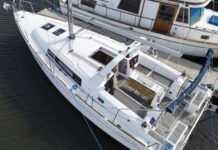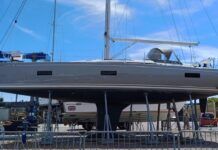Perhaps it was somebodys idea of a joke. Who walks away from their boat and leaves the engine running? But when I climbed back aboard after being away for several days, there it was-the unmistakable sound of my Ford-Lehman diesel.
Pilot house doors were locked; nobody in sight. Whoever did this had to be watching just to see the reaction. Right?
Opened the doors and found the start key off. The engine can’t run with the key off. Thats what it says in the manual.
Tach said 650 rpm. The other gauges showed nothing. Turn the key on and theres 160 engine temp, 45 pounds of oil pressure and 15 volts in the batteries. Way too high! Batteries have to be boiling.
Turn the key off.
The engine keeps running.
All right, I yelled. Who did this?
Open the engine hatch, expect to find a kluge of clipped-on leads connected somehow to make the engine run. Nothing.
Decide the only way to turn the engine off is to set the engine battery switch to None. But its already there. Of course. I always turn off the batteries when leaving the boat. Theres no way to turn off the engine.
Cant help but believe somebody is watching. Do some serious looking around. Nobody is about. Cant even ask anyone if theyve seen anything unusual.
Back in the engine room. Theres a solenoid somewhere that cuts off the fuel when the key is turned off. Trusty meter says its being powered by 15 volts, coming from the alternator. The key is off, so how can that be?
Need to do something. Pull the field sensor lead out of the alternators regulator.
The engine stops. Whew!!
Check the engine log versus the hours meter. Its been about seven hours since I changed the oil. Used the engine a couple of times, so calculate that the engine has been on its mystery run for maybe four or five hours. That means it started at 5 or 6 in the morning.
Recall that at home, a thunderstorm woke me. Lots of lightning. Back on deck to check the lightning chain hanging over the side.
Gone!
Burn marks on the toe rail; they rub off with a finger. No burn marks anywhere else. Strange. But could it be that lightning started the engine? Lightning is fickle.
While waiting for the engine to cool, I checked all of the onboard electronics. Radar, GPS and both autopilots are okay. But one of two depth finders is dead. So are the two overhead radios and the old Sitex Sat-Nav and the Sea Ranger loran.
Examine the masthead with binoculars. Looks normal. No burn marks on the mast, either.
But if the mast was hit, how did the bolt get to the engine? The only conceivable path was through coax shields and mast light wires, none of which could sustain starter currents. The mast is totally isolated from anything metallic, the only path to ground being the lightning chain hung over the side. Even the engine is electrically isolated from ground by a shaft vibration damper which was installed specifically to reduce any stray-current galvanic effects. Its what one does in Florida, the lightning capital of the continental United States.
Now for the real witch hunt.
Found several seriously burned wires. The purple start-key wire, alternator field sensor wire and starter solenoid wire were the worst. All were melted in several places but, oddly enough, none was touching anything that may have caused a short or overload.
The feedback diode from the battery isolator used to set the regulator so that no battery could exceed 14.2 volts had been converted to a resistor. This accounts for the battery over-charging. The wire carrying this connection had an exploded opening through the insulation, but where the arc may have gone could not be determined.
A #10 wire from the overhead electronics was exploded away from its connection in the battery box. The radios, sat-nav and loran actually were undamaged. And the depth sounder does, in fact, work, but the through-hull transducer does not. There are no signs of excessive currents in any of the connections and none of the wires are close to the engine wiring.
A burn mark was found on the fiberglass where a wire runs out of the overhead to a small horn mounted under the pilothouse roof. The wiring is okay, but the horn doesn’t work. If the horn was hit, it would account for the lost ground to the electronics.
After all burnt wiring was replaced, everything is fine-except for the transducer and horn. The engine starter works and the engine runs well.
A dozen or so years ago, the mast was fitted out with short pointed radials extending out from a plate attached to the top. The radials were intended to be corona discharge points to support the theory that if the high potential between a cloud and ground could be leaked off before it reached arcing point, a lightning strike would not happen. This technique has been effective where lightning frequently threatens radio stations and antennas. The difference, however, is that in such installations there are many corona discharge points surrounding the facility. On a sailboat, they can only be mounted on the mast top.
Does it work? Because this is, in almost 13 years, the only hit Ive had in this lightning-infested area, I think so. But apparently the chain wasnt big enough to survive the hit.
-Richard Wilkens
Ed. Note: For a different opinion on static dissipators, claiming they are too easily overwhelmed, see Why You Cant Fool Thor in the July 15, 1995 issue.




































